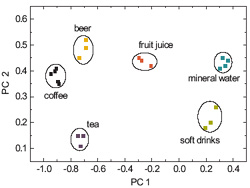|
|
Vol.
28 No. 2
March-April 2006
Nonspecific Sensor Arrays (“electronic tongue”) for Chemical Analysis of Liquids (IUPAC Technical Report)
Yuri Vlasov, A. Legin, A. Rudnitskaya,
C. Di Natale, and A. D’Amico
Pure and Applied Chemistry
Vol. 77, No. 11, pp. 1965–1983 (2005)
doi:10.1351/pac200577111965
The history of the development of potentiometric sensors over
the past century demonstrates progress in constructing single,
discrete (i.e., separate, to distinguish from sensor arrays)
ion sensors, which have been made as selective as possible.
Only a few types reveal high selectivity. However, easy measurement
procedures, with low cost and availability, have given rise
to the search for new ways to successfully apply them.
 |
Discriminating abilities of the electronic tongue with
respect to different types of beverages. PC1 and PC2
are produced by principal component analysis (PCA)
when data dimension is reduced from 30D (the number of sensors in the array) to the 2D presentation shown in this figure. PC1 and PC2 are the most significant species containing the largest part of information about the analyzed beverages (from A.V. Legin et al., Sens. Actuators, B 44, 291 (1997)). |
This
document describes a new concept for the application of potentiometric
multisensor systems (i.e., sensor arrays for solution analysis)
and the performance of this new analytical tool — the
“electronic tongue.” The electronic tongue is
a multisensor system that consists of a number of low-selective
sensors and uses advanced mathematical procedures for signal
processing based on the pattern recognition (PARC) and/or
multivariate analysis (e.g., artificial neural networks (ANNs),
principal component analysis (PCA)). Definitions of the multisensor
systems and their parameters are suggested. Results from the
application of the electronic tongue, both for quantitative
and qualitative analysis of different mineral water and wine
samples, are presented and discussed.
www.iupac.org/publications/pac/2005/7711/7711x1965.html
Page
last modified 10 August 2006.
Copyright © 2003-2006 International Union of Pure and
Applied Chemistry.
Questions regarding the website, please contact [email protected]
|